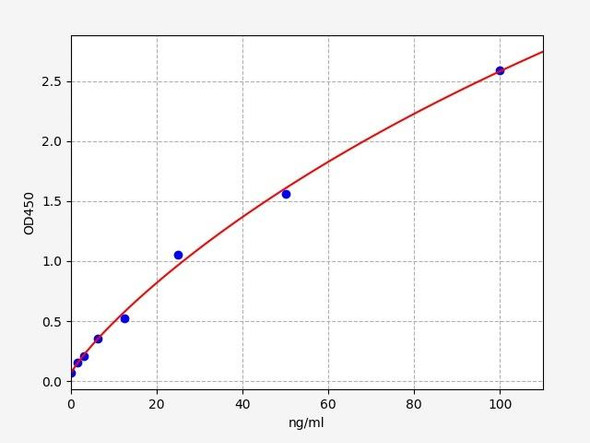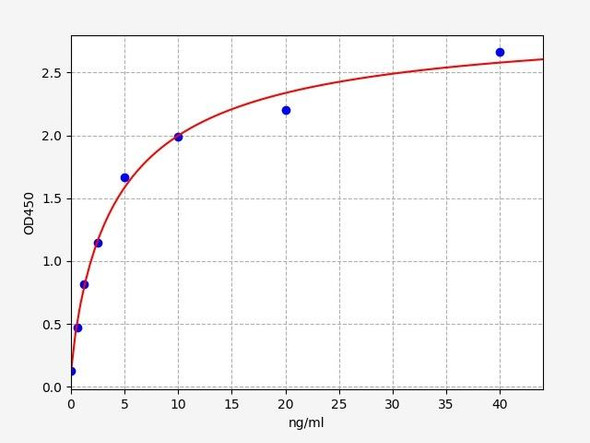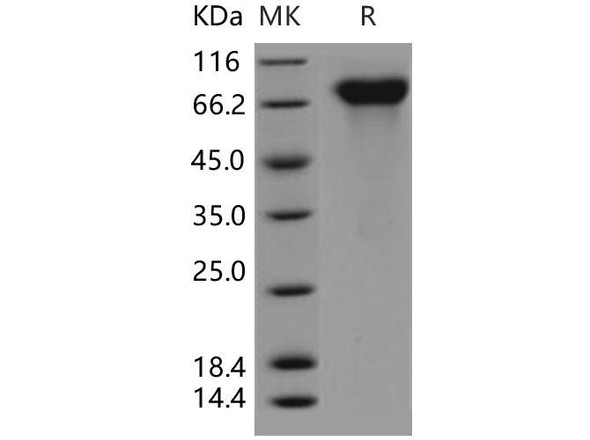Human PROS1 / Protein S ELISA Kit
- SKU:
- HUFI01701
- Product Type:
- ELISA Kit
- Size:
- 96 Assays
- Uniprot:
- P07225
- Sensitivity:
- 3.75ng/ml
- Range:
- 6.25-400ng/ml
- ELISA Type:
- Sandwich
- Synonyms:
- PROS1, Vitamin K-dependent protein S, PSA, PROS, PS21, PS22, PS23, PS24, PS25, THPH5, THPH6, protein S, alpha, protein Sa, vitamin K-dependent plasma protein S, vitamin K-dependent protein S
- Reactivity:
- Human
- Research Area:
- Cardiovascular
Description
Human PROS1 / Protein S ELISA
PROS1 (Protein S) is a serine protease that is produced by liver cells and stored in the alpha-2 macroglobulin (A2M) complex. It is a cofactor for the activated protein C (APC) pathway, which plays a role in regulating blood clotting and inflammation. PROS1 deficiency can lead to increased risk of thrombosis and inflammation. Diseases associated with PROS1 include Thrombophilia Due To Protein S Deficiency, Autosomal Recessive and Thrombophilia Due To Protein S Deficiency, Autosomal Dominant.
| Product Name: | Human PROS1 / Protein S ELISA Kit |
| Product Code: | HUFI01701 |
| Size: | 96 Assays |
| Alias: | PROS1, Vitamin K-dependent protein S, PSA, PROS, PS21, PS22, PS23, PS24, PS25, THPH5, THPH6, protein S, alpha, protein Sa, vitamin K-dependent plasma protein S, vitamin K-dependent protein S |
| Detection method: | Sandwich ELISA, Double Antibody |
| Application: | This immunoassay kit allows for the in vitro quantitative determination of Human PROS1 concentrations in serum plasma and other biological fluids. |
| Sensitivity: | 3.75ng/ml |
| Range: | 6.25-400ng/ml |
| Storage: | 4°C for 6 months |
| Note: | For Research Use Only |
| Recovery: | Matrices listed below were spiked with certain level of Human PROS1 and the recovery rates were calculated by comparing the measured value to the expected amount of Human PROS1 in samples. | ||||||||||||||||
| |||||||||||||||||
| Linearity: | The linearity of the kit was assayed by testing samples spiked with appropriate concentration of Human PROS1 and their serial dilutions. The results were demonstrated by the percentage of calculated concentration to the expected. | ||||||||||||||||
| |||||||||||||||||
| CV(%): | Intra-Assay: CV<8% Inter-Assay: CV<10% |
| Component | Quantity | Storage |
| ELISA Microplate (Dismountable) | 8×12 strips | 4°C for 6 months |
| Lyophilized Standard | 2 | 4°C/-20°C |
| Sample/Standard Dilution Buffer | 20ml | 4°C |
| Biotin-labeled Antibody(Concentrated) | 120ul | 4°C (Protect from light) |
| Antibody Dilution Buffer | 10ml | 4°C |
| HRP-Streptavidin Conjugate(SABC) | 120ul | 4°C (Protect from light) |
| SABC Dilution Buffer | 10ml | 4°C |
| TMB Substrate | 10ml | 4°C (Protect from light) |
| Stop Solution | 10ml | 4°C |
| Wash Buffer(25X) | 30ml | 4°C |
| Plate Sealer | 5 | - |
Other materials and equipment required:
- Microplate reader with 450 nm wavelength filter
- Multichannel Pipette, Pipette, microcentrifuge tubes and disposable pipette tips
- Incubator
- Deionized or distilled water
- Absorbent paper
- Buffer resevoir
| Uniprot | P07225 |
| UniProt Protein Function: | PROS1: Anticoagulant plasma protein; it is a cofactor to activated protein C in the degradation of coagulation factors Va and VIIIa. It helps to prevent coagulation and stimulating fibrinolysis. Defects in PROS1 are the cause of thrombophilia due to protein S deficiency, autosomal dominant (THPH5). A hemostatic disorder characterized by impaired regulation of blood coagulation and a tendency to recurrent venous thrombosis. However, many adults with heterozygous disease may be asymptomatic. Based on the plasma levels of total and free PROS1 antigen as well as the serine protease-activated protein C cofactor activity, three types of PROS1D have been described: type I, characterized by reduced total and free PROS1 antigen levels together with reduced anticoagulant activity; type III, in which only free PROS1 antigen and PROS1 activity levels are reduced; and the rare type II which is characterized by normal concentrations of both total and free PROS1 antigen, but low cofactor activity. Defects in PROS1 are the cause of thrombophilia due to protein S deficiency, autosomal recessive (THPH6). A very rare and severe hematologic disorder resulting in thrombosis and secondary hemorrhage usually beginning in early infancy. Some affected individuals develop neonatal purpura fulminans, multifocal thrombosis, or intracranial hemorrhage. |
| UniProt Protein Details: | Protein type:Secreted; Secreted, signal peptide Chromosomal Location of Human Ortholog: 3q11.2 Cellular Component: Golgi membrane; extracellular space; endoplasmic reticulum membrane; Golgi lumen; plasma membrane; extracellular region Molecular Function:endopeptidase inhibitor activity; calcium ion binding Biological Process: platelet activation; fibrinolysis; platelet degranulation; cellular protein metabolic process; regulation of complement activation; innate immune response; proteolysis; blood coagulation; post-translational protein modification; leukocyte migration; peptidyl-glutamic acid carboxylation Disease: Thrombophilia Due To Protein S Deficiency, Autosomal Recessive; Thrombophilia Due To Protein S Deficiency, Autosomal Dominant |
| NCBI Summary: | This gene encodes a vitamin K-dependent plasma protein that functions as a cofactor for the anticoagulant protease, activated protein C (APC) to inhibit blood coagulation. It is found in plasma in both a free, functionally active form and also in an inactive form complexed with C4b-binding protein. Mutations in this gene result in autosomal dominant hereditary thrombophilia. An inactive pseudogene of this locus is located at an adjacent region on chromosome 3. [provided by RefSeq, Feb 2009] |
| UniProt Code: | P07225 |
| NCBI GenInfo Identifier: | 131086 |
| NCBI Gene ID: | 5627 |
| NCBI Accession: | P07225.1 |
| UniProt Secondary Accession: | P07225,Q08761, P53813, |
| UniProt Related Accession: | P07225 |
| Molecular Weight: | 676 |
| NCBI Full Name: | Vitamin K-dependent protein S |
| NCBI Synonym Full Names: | protein S (alpha) |
| NCBI Official Symbol: | PROS1 |
| NCBI Official Synonym Symbols: | PSA; PROS; PS21; PS22; PS23; PS24; PS25; THPH5; THPH6 |
| NCBI Protein Information: | vitamin K-dependent protein S; protein Sa; vitamin K-dependent plasma protein S |
| UniProt Protein Name: | Vitamin K-dependent protein S |
| Protein Family: | Protein |
| UniProt Gene Name: | PROS1 |
| UniProt Entry Name: | PROS_HUMAN |
*Note: Protocols are specific to each batch/lot. For the correct instructions please follow the protocol included in your kit.
Before adding to wells, equilibrate the SABC working solution and TMB substrate for at least 30 min at 37°C. When diluting samples and reagents, they must be mixed completely and evenly. It is recommended to plot a standard curve for each test.
| Step | Protocol |
| 1. | Set standard, test sample and control (zero) wells on the pre-coated plate respectively, and then, record their positions. It is recommended to measure each standard and sample in duplicate. Wash plate 2 times before adding standard, sample and control (zero) wells! |
| 2. | Aliquot 0.1ml standard solutions into the standard wells. |
| 3. | Add 0.1 ml of Sample / Standard dilution buffer into the control (zero) well. |
| 4. | Add 0.1 ml of properly diluted sample ( Human serum, plasma, tissue homogenates and other biological fluids.) into test sample wells. |
| 5. | Seal the plate with a cover and incubate at 37 °C for 90 min. |
| 6. | Remove the cover and discard the plate content, clap the plate on the absorbent filter papers or other absorbent material. Do NOT let the wells completely dry at any time. Wash plate X2. |
| 7. | Add 0.1 ml of Biotin- detection antibody working solution into the above wells (standard, test sample & zero wells). Add the solution at the bottom of each well without touching the side wall. |
| 8. | Seal the plate with a cover and incubate at 37°C for 60 min. |
| 9. | Remove the cover, and wash plate 3 times with Wash buffer. Let wash buffer rest in wells for 1 min between each wash. |
| 10. | Add 0.1 ml of SABC working solution into each well, cover the plate and incubate at 37°C for 30 min. |
| 11. | Remove the cover and wash plate 5 times with Wash buffer, and each time let the wash buffer stay in the wells for 1-2 min. |
| 12. | Add 90 µl of TMB substrate into each well, cover the plate and incubate at 37°C in dark within 10-20 min. (Note: This incubation time is for reference use only, the optimal time should be determined by end user.) And the shades of blue can be seen in the first 3-4 wells (with most concentrated standard solutions), the other wells show no obvious color. |
| 13. | Add 50 µl of Stop solution into each well and mix thoroughly. The color changes into yellow immediately. |
| 14. | Read the O.D. absorbance at 450 nm in a microplate reader immediately after adding the stop solution. |
When carrying out an ELISA assay it is important to prepare your samples in order to achieve the best possible results. Below we have a list of procedures for the preparation of samples for different sample types.
| Sample Type | Protocol |
| Serum | If using serum separator tubes, allow samples to clot for 30 minutes at room temperature. Centrifuge for 10 minutes at 1,000x g. Collect the serum fraction and assay promptly or aliquot and store the samples at -80°C. Avoid multiple freeze-thaw cycles. If serum separator tubes are not being used, allow samples to clot overnight at 2-8°C. Centrifuge for 10 minutes at 1,000x g. Remove serum and assay promptly or aliquot and store the samples at -80°C. Avoid multiple freeze-thaw cycles. |
| Plasma | Collect plasma using EDTA or heparin as an anticoagulant. Centrifuge samples at 4°C for 15 mins at 1000 × g within 30 mins of collection. Collect the plasma fraction and assay promptly or aliquot and store the samples at -80°C. Avoid multiple freeze-thaw cycles. Note: Over haemolysed samples are not suitable for use with this kit. |
| Urine & Cerebrospinal Fluid | Collect the urine (mid-stream) in a sterile container, centrifuge for 20 mins at 2000-3000 rpm. Remove supernatant and assay immediately. If any precipitation is detected, repeat the centrifugation step. A similar protocol can be used for cerebrospinal fluid. |
| Cell culture supernatant | Collect the cell culture media by pipette, followed by centrifugation at 4°C for 20 mins at 1500 rpm. Collect the clear supernatant and assay immediately. |
| Cell lysates | Solubilize cells in lysis buffer and allow to sit on ice for 30 minutes. Centrifuge tubes at 14,000 x g for 5 minutes to remove insoluble material. Aliquot the supernatant into a new tube and discard the remaining whole cell extract. Quantify total protein concentration using a total protein assay. Assay immediately or aliquot and store at ≤ -20 °C. |
| Tissue homogenates | The preparation of tissue homogenates will vary depending upon tissue type. Rinse tissue with 1X PBS to remove excess blood & homogenize in 20ml of 1X PBS (including protease inhibitors) and store overnight at ≤ -20°C. Two freeze-thaw cycles are required to break the cell membranes. To further disrupt the cell membranes you can sonicate the samples. Centrifuge homogenates for 5 mins at 5000xg. Remove the supernatant and assay immediately or aliquot and store at -20°C or -80°C. |
| Tissue lysates | Rinse tissue with PBS, cut into 1-2 mm pieces, and homogenize with a tissue homogenizer in PBS. Add an equal volume of RIPA buffer containing protease inhibitors and lyse tissues at room temperature for 30 minutes with gentle agitation. Centrifuge to remove debris. Quantify total protein concentration using a total protein assay. Assay immediately or aliquot and store at ≤ -20 °C. |
| Breast Milk | Collect milk samples and centrifuge at 10,000 x g for 60 min at 4°C. Aliquot the supernatant and assay. For long term use, store samples at -80°C. Minimize freeze/thaw cycles. |
Fill out our quote form below and a dedicated member of staff will get back to you within one working day!






